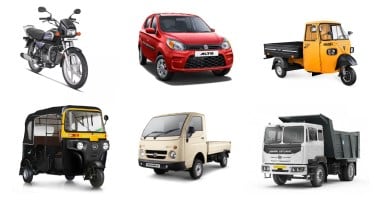The automotive retail sales numbers for October are out, and there is more than what meets the eye. A total of 21,17,596 vehicles were sold, which was 7.73 percent lower compared to the same period last year. Barring the two-wheelers and four-wheeler registration, all segments were in the green.
Manish Raj Singhania, President, FADA said, “The month commenced under the shadow of the inauspicious Shraddh period, persisting until the 14th. Consequently, a YoY comparison may not accurately reflect the actual trajectory of growth in the Indian auto retail sector. When compared MoM, auto retails flourished, achieving a 13% increase, with contributions from all categories. Two-wheelers, three-wheelers, passenger vehicles, tractors, and commercial vehicles expanded by 15%, 2%, 7%, 15%, and 10%, respectively, underscoring the sector’s robust growth momentum.”
He further stated that Navratri of 2023 marked a milestone with retail sales soaring by 18% YoY, surpassing the figures of Navratri 2017. Barring tractors, which declined by 8 percent, all categories exhibited commendable growth. Two-wheelers, three-wheelers, commercial vehicles, and passenger vehicles experienced increases of 22%, 43%, 9%, and 7%, respectively.
| CATEGORY | OCT’23 | OCT’22 | YoY % | SEP’23 | MoM % |
| Two-wheelers | 15,07,756 | 17,25,043 | -12.60% | 13,12,101 | 14.91% |
| Three-wheelers | 1,04,711 | 71,903 | 45.63% | 1,02,426 | 2.23% |
| E-RICKSHAW(P) | 45,734 | 31,613 | 44.67% | 46,707 | -2.08% |
| E-RICKSHAW WITH CART (G) | 3,023 | 2,024 | 49.36% | 3,038 | -0.49% |
| THREE WHEELER (GOODS) | 10,067 | 7,369 | 36.61% | 9,014 | 11.68% |
| THREE WHEELER (PASSENGER) | 45,814 | 30,852 | 48.50% | 43,581 | 5.12% |
| THREE WHEELER (PERSONAL) | 73 | 45 | 62.22% | 86 | -15.12% |
| Passenger vehicles | 3,53,990 | 3,58,884 | -1.36% | 3,32,248 | 6.54% |
| Tractors | 62,440 | 58,823 | 6.15% | 54,492 | 14.59% |
| Commercial vehicles | 88,699 | 80,446 | 10.26% | 80,804 | 9.77% |
| LCV | 49,666 | 49,053 | 1.25% | 46,213 | 7.47% |
| MCV | 5,980 | 4,792 | 24.79% | 5,623 | 6.35% |
| HCV | 28,940 | 24,300 | 19.09% | 25,237 | 14.67% |
| Others | 4,113 | 2,301 | 78.75% | 3,731 | 10.24% |
| Total | 21,17,596 | 22,95,099 | -7.73% | 18,82,071 | 12.51% |
The two-wheeler segment during Navratri and throughout October saw several positive trends, buoyed by festive cheer and stronger rural demand. Enhanced availability of models, especially those in high demand from the previous year, along with better financial schemes, contributed to a solid market momentum. States going into elections also injected optimism into the market, leading to an increase in government spending and improved liquidity. Despite a shift in festival dates, with Diwali moving to November, the anticipation of the festive season stimulated purchase intent and dealers reported good stock preparation and robust ground efforts that led to an uptick in sales figures, showcasing a resilient and adaptive market.
The three-wheeler segment was largely driven by competitive finance options and a significant rise in e-rickshaw interest, signalling a healthy move towards electrification. October continued the positive trend with robust market sentiments and festive celebrations contributing to increased customer bookings.
The commercial vehicle segment too experienced robust bookings and a positive uptake in retail sales, buoyed by festive cheer and strategic price support from manufacturers. The demand for LCVs and SCVs surged, driven by infrastructure development activities and the need for vehicle replacement. Healthy demand was witnessed especially in segments like cement, iron ore and coal transport. The festive seasons, including Navratri, catalysed market activity, with customers taking advantage of favourable finance schemes.
The passenger vehicle segment navigated a complex landscape, marked by both enthusiasm and caution. During Navratri, despite regional variability, the industry witnessed a surge in bookings, buoyed by the introduction of compelling new models, particularly SUVs and the availability of attractive consumer offers. However, the impact of local elections and market saturation meant that the festive spirit didn’t translate uniformly into sales across all regions.
“Throughout the month, the anticipation for Diwali in November and the launch of new models generated a steady demand. The period overall saw a resilient PV market, supported by a stronger product line-up unlike last year, when stock availability was a major issue,” added Singhania.
PV inventory needs correction
FADA says the near-term outlook for the auto sector is a blend of highs and lows as we approach year-end. Festivities along with harvest season (especially paddy) are expected to boost two-wheeler sales, with optimism fuelled by new schemes and a push towards electrification, despite supply concerns. CV’s are looking at a strong November, with festive and construction activities enhancing demand, alongside anticipated financial schemes.
However, the PV segment is navigating through a tricky phase. Festive days might spike bookings, yet the shadow of year-end discounts looms over immediate sales. High inventory levels in PVs, at a critical 63–66-days range, demand urgent attention from OEMs. Without substantial interventions and if Diwali sales don’t rise to the occasion, the weight of unsold stock could lead to significant dealer distress, echoing FADA’s concerns for potential industry-wide repercussions. Immediate and decisive action is imperative to counter the risk of a financial squeeze as the year closes.
